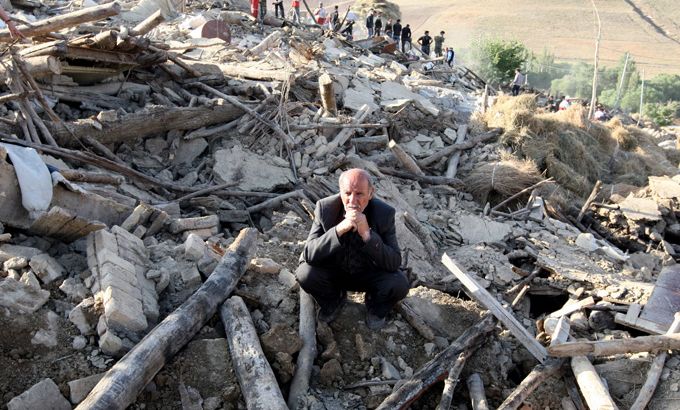Quake-hit Iranians facing harsh winter
Two August earthquakes left 100,000 homeless, and many remain living in unforgiving conditions as winter approaches.

Hiag, Iran – A grown man, resilient from a life of hard work and circumstance, is reduced to tears. His hands are caked in dirt, swollen from the cold and physical labour.
Mohammad Hamiat and his wife lost their home and everything in it in Iran’s twin earthquakes on August 11, which killed more than 300 people in the country’s isolated northwest. They now live in a tattered tent donated by the Iranian Red Crescent, with the cold of winter fast approaching.
Keep reading
list of 4 itemsAfter the Hurricane
World’s coral reefs face global bleaching crisis
Why is Germany maintaining economic ties with China?
The twin quakes rendered more than 100,000 people homeless and destroyed almost 12,000 houses. Exactly four months after the temblors struck, most people in the remote village of Hiag are still without permanent shelter – despite government promises that their demolished houses would be rebuilt.
|
“At night we wear three jackets. Even animals cannot tolerate the coldness, let alone us.“ – Mohammad Hamiat, quake survivor |
The Hamiats have blankets, a few plastic dishes, a heater, and the clothes on their backs, but not much more. They’ve waited for four months for a new home to be built, just metres away from their tent. Mohammad Hamiat says it’s a cruel frustration he faces every day – forced to look at what circumstance has made of his life, while waiting for the reconstruction to happen.
Life is difficult and only getting worse. When it rains, the tent leaks. Then there’s the snow that’s already falling in the nearby mountains, and the start of the harsh Iranian winter is just 10 days away.
Hamiat’s wife displays the soles of her dirty, deeply creviced feet. The reason for their rough condition, she says, is that there’s no hot water to wash properly.
“At night we wear three jackets. Even animals cannot tolerate the coldness, let alone us,” Hamiat says in his thin white tent, as his wife prepares tea and pomegranate on its hard floor.
Most people here are impoverished farmers who survive by working the land, but their livelihoods have been severely altered by the quakes. Wheat that normally would have been grown could not be planted because of land destruction and the victims’ stagnant situation.
Promises broken
After the August quakes, the Iranian government promised survivors they would have reconstructed homes in two-and-a-half months, before severe winter took hold. Back then it looked possible, as the government in Tehran moved quickly to start clearing rubble.
But today, few homes are complete and frustrations are growing.
Engineers defend their building efforts, saying they’re facing massive challenges.
“A lack of workers and contractors is the problem because it’s a huge project and there are a lot of villages,” says Ali Gheshlaghi, an engineering supervisor in Hiag, about 500 kilometres northwest of the capital Tehran.
“There’s also an issue of getting material. It’s not the season for construction, but because of the earthquake we have to do it.”
Just clearing the rubble from the village, which was completely destroyed, took almost two months, Gheshlaghi says. “We’ve finished 10 to 35 houses here, but people haven’t moved in yet. If the weather is good, all the houses should be finished in three weeks.”
|
“Mismanagement has meant that people in 63 villages still live in tents though the snow and cold has already arrived.” – Allahverdi Dehqani |
But Hamiat says that’s not going to happen, and accuses the contractors of corruption.
“They lie. They work better for anyone who pays them off. Our construction is going so slowly. The engineers told us if we pay them they’ll work better, but I have no money,” he says.
Others have also cited financial mismanagement as a reason for the lack of progress.
Allahverdi Dehqani, a lawmaker from the region, told Iran’s parliament last month that only 15 percent of people affected by the quakes have been resettled.
“Mismanagement has meant that people in 63 villages still live in tents though the snow and cold has already arrived,” the Vatan Emrooz daily quoted Dehqani as saying.
Slow progress
Not all people in the quake-stricken region are living in tents like the Hamiats. Most are dwelling in temporary metal shelters, scattered throughout the villages.
The story is the same across battered East Azerbaijan province, with people complaining of a lack of proper housing, running water and amenities.
The governor of the province, Ahmad Ali Reza Beigi, tells Al Jazeera people need to understand the difficulty of what the government has faced.
“The affected area covers 5,000 square kilometres. It’s a complicated project,” Beigi says. “Most of the problems are related to people who only live in the villages in spring and summer [months] – our priority is permanent residents. But they think if we don’t build the houses now, they won’t ever be built.”
Some problems holding up reconstruction are caused by villagers who are unwilling to cooperate with contractors, says Beigi.
Iran’s economic crisis has also been a contributing factor to the plight of the quake victims, with the value of the rial tanking and inflation steadily rising – making basic goods and raw materials much more expensive.
This is part of the government’s rationale for “prioritising” houses for families on a case-by-case basis, Beigi says, and by the New Year the authorities plan to have all priority homes complete.
For Mohammad Hamiat, however, not being considered a “priority” by the government does not sit well.
“Who should help us? We have no life, no water, no bathroom, no money, no clothes and no food,” Hamiat says, with tears streaming from his eyes.